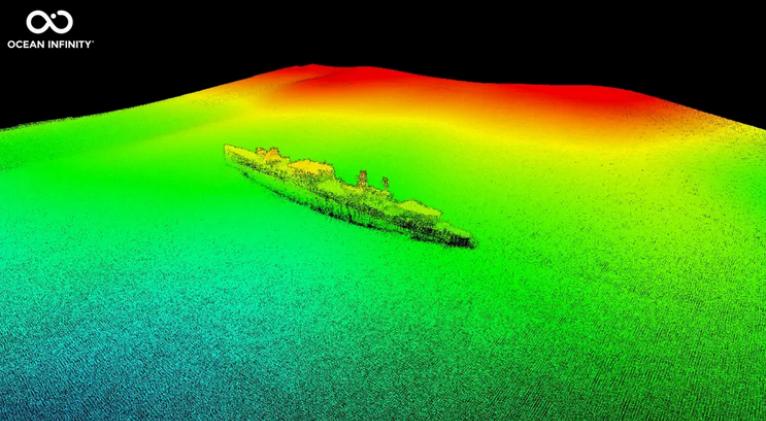
USA, Oct 3.- On August 1, about 110 kilometers northwest of San Francisco, a ship dropped its unusual cargo into the ocean: three orange torpedo-shaped robots, each more than six meters long. For a day, the aquatic drones autonomously roamed the waters, examining almost 130 square kilometers of ocean floor.
About 1,100 meters below the surface, the robots' powerful sonar detected an apparition. In the darkness, the drones saw a ghost.
The robots had detected the wreckage of the “Pacific Ghost Ship,” the only U.S. Navy destroyer captured by Japanese forces during World War II. Formerly known as USS Stewart or DD-224, the ship rested in what is now the Cordell Bank National Marine Sanctuary.
Three days later, another set of underwater robots captured images of the historic wreck. Although it was enveloped in decades of marine vegetation—and home to sponges and slippery crabs—the 96-meter-long destroyer is virtually intact, standing tall on the seafloor.
"This level of preservation is exceptional for a ship of its age and potentially makes it one of the best-preserved examples of a US Navy 'four-funnel' destroyer known," explained in a statement Maria Brown, superintendent of the Cordell Bank and Greater Farallones national marine sanctuaries.
The discovery, which occurred during a technology demonstration, highlights the effectiveness of modern robotic ocean exploration. Ocean Infinity, the marine robotics company that operated the drones that made the discovery, owns the world's largest fleet of autonomous underwater vehicles. Drones are used to create high-resolution maps of the seafloor, a major gap in our understanding of the oceans. The technology is also crucial for selecting sites for offshore construction projects, such as wind farms and oil platforms, or for laying out routes for undersea pipelines and cables.
These robotic fleets are also proving invaluable to marine archaeologists. In 2020, Ocean Infinity helped find the wreckage of the USS Nevada. In 2022, the company also contributed to the rediscovery of the Endurance, which sank during an expedition by Ernest Shackleton in 1915.
“We are in the middle of what I think is a sea change in ocean discovery,” said Jim Delgado, senior vice president of SEARCH, Inc, a maritime archeology company involved in the discovery of DD-224.
Delgado joined the search for DD-224 a decade ago as director of maritime heritage for the National Oceanic and Atmospheric Administration (NOAA), which oversees more than 1.6 million square kilometers of underwater parks in USA. Marine archaeologists have long been fascinated by the ship's unusual story.
After being sunk and abandoned off the coast of Java in 1942, DD-224 was salvaged by Japanese forces, who used it to escort their naval convoys. Allied pilots reported seeing what looked like one of their own ships deep behind enemy lines.
In a symbolic farewell to the ship following its postwar recovery, the U.S. Navy returned DD-224 to service, towed it to California, and then sank the vessel at sea with a hail of practice gunfire shot on May 24, 1946. After enduring two hours of fire, the stubborn ship gave way and sank.
“The entire history of that ship was exceptionally well documented,” said Russ Matthews, president of the nonprofit Air/Sea Heritage Foundation and a member of the team that made the discovery. “The only piece of that story we didn't have is: What does it look like today?”
For years, Matthews attempted several times to locate the ship's last known coordinates. An initial lead from a colleague, Lonnie Schorer, turned to a 1946 U.S. Navy statement that limited the search to what is now the Cordell Bank Shrine. But no NOAA ships sailing through the sanctuary found the ship, and Matthews and his colleagues couldn't get funding to go themselves.
Luck changed in April this year following a meeting between Matthews and Andy Sherrell, Ocean Infinity's director of marine operations. The company wanted to test using several of its largest autonomous drones at the same time. Why don’t we try to find DD-224?
Matthews had made a breakthrough in the case, tracking the coordinates of the tugboat that took DD-224 to the area where it sank. With permission from NOAA, Ocean Infinity headed there. Sherrell noted that under the sea, mapping a 37-square-nautical-mile region—DD-224's search area—typically takes weeks. Ocean Infinity drones located the ghost ship within hours.
“We covered it very quickly and in high resolution,” Sherrell said.
The terabytes of data collected by Ocean Infinity now constitute the best map of that part of the Cordell Bank sanctuary. The data set also brings to an end the eight-decade history of a ship whose significance always went beyond the steel that now corrodes in the depths.
Once DD-224 was recovered, the American crew that brought it home preferred to call it RAMP-224, an acronym for “Recovered Allied Military Personnel,” a term used at that time to refer to liberated prisoners of war.
“In its own way, this ship was humanized by the Navy,” Delgado said. “People put a lot into boats and we have done that since the beginning of time.”They represent us." (Text and Photo: Cubasí)